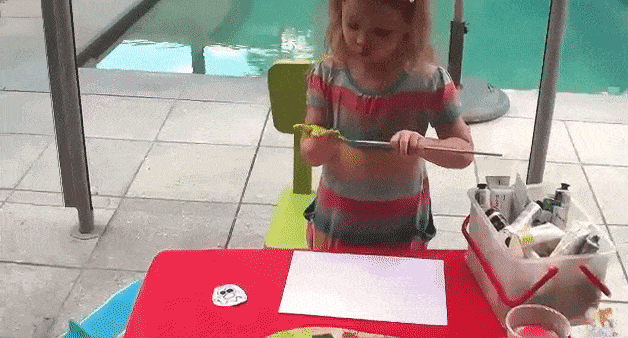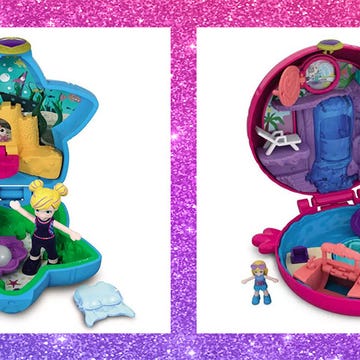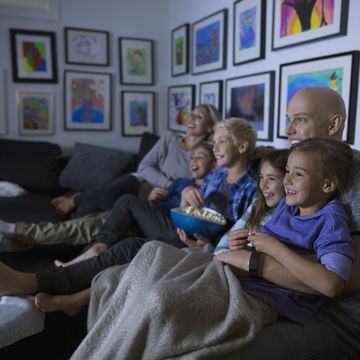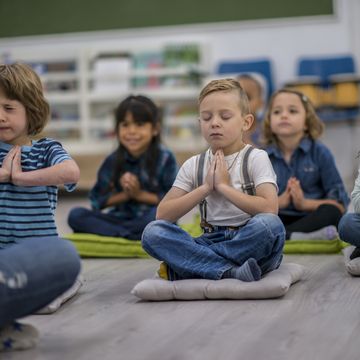Admit it: Sometimes you wish your kid would magically disappear. Not forever — just for half an hour so you can read the paper in peace or chat with a (grown-up) friend. But it's hard separating from your child, not only because he clings to your leg whenever you try to leave the room, but because you don't want to miss a beat of his development...and you might secretly relish being wanted so much (hey, we feel ya). Not to mention you probably feel at least a little guilty about "abandoning" him.
"Many parents believe that they should constantly engage with their children, but that mentality leaves no time for relaxation — and creates stress that your kids pick up on," says psychologist Kathy Hirsh-Pasek, PhD, coauthor of Einstein Never Used Flash Cards. In fact, training them to play on their own (what the experts call solitary play) is one of the greatest gifts you can bestow. "It's the downtime for scribbling, making a car out of a cardboard box, or exploring the backyard that fosters the skills your child needs to be successful and fulfilled: Creativity, critical thinking, and confidence," Hirsh-Pasek says.
1. Show Them How It's Done
The first step in teaching your child to be okay with being alone is showing him how fun it can be. This process begins even before he can crawl. "To a certain extent, being alone is a learned behavior, and if you never leave your baby, he won't learn to settle himself," says Cynthia Chandler, PhD, assistant professor of early childhood education at Black Hill State University in Spearfish, SD. "Putting your child in a playpen or crib with a few toys while you hang out nearby — or even leave the room — will plant the seeds of self-soothing and focus." Rattles, stacking rings, and other easy-to-grasp objects can keep a six-month-old busy for up to 20 minutes — enough time for you to grab a cup of coffee.
Once your little one can scoot around, your alone time needs to happen in viewing (and pouncing) distance of him. Happily, toddlers find the world so fascinating that they'll play enthusiastically for 15 minutes or more with colorful scarves or wooden spoons. As they discover their joys and passions, share yours: Sometime around your kid's second birthday, start talking out loud about the things you love to do alone and why. "Our children gain so much from their parents' being people with interests," Hirsh-Pasek says. "When they see you dancing, they'll twirl and leap. When there are readers in the house, they'll appreciate books."
Some children take naturally to solo play; others require more guidance to get their imaginations rolling. "One of my twins gets lost in her dolls while her sister needs me to set her up with an art project or a book," says Victoria Loveland-Coen, 47, of Chapel Hill, NC. Gradually increase the amount of time that you leave your child alone. Try setting a timer and explain that she has to stay in her room until it dings. "Offer positive reinforcement, like, 'You did such a great job building towers on your own.' You want her to internalize your confidence that she can be self-sufficient," says Michele Borba, author of The Big Book of Parenting Solutions.
2. Create a Kid-Proof Space
"The best way to encourage your child to lose herself in independent activities is to create secure, baby-proofed play areas in your home and yard that encourage experimentation," says psychologist Margaret Paul, PhD, coauthor of Do I Have to Give Up Me to Be Loved by My Kids?
Michelle Workman, 39, a Los Angeles interior designer, created a wondrous playroom for her two sons, complete with oversize stuffed animals, a fake tree, and a built-in desk and toy boxes. "I covered the space in a thick, dark green shag rug with a pad underneath so heads and elbows are cushioned against falls," she says. "Saturday mornings, we put snacks in the room for them and buy ourselves some extra lounging time."
You don't have to dedicate a whole room to your tots — even a low kitchen drawer full of Tupperware can be a treasure trove. "I keep a basket of toys and books in each room," says Evanston, IL, mom of four Liz Hletko, 39. "When I go into another room for mommy time, the kids have basket time." Rotating out the toys, books, and supplies in your bins about once a month will keep your child from getting overwhelmed and make the train set or dinosaurs you stashed away for four weeks exciting again. According to experts — and moms — kid-space essentials include building blocks, Duplos and Legos, costumes, and crayons, paper plates, and other art supplies. "Open-ended toys stretch your kid's creativity, so they'll keep your kid occupied much longer," Borba says.
3. Keep Them Engaged
Chandler recalls giving her elementary-school students a homework assignment to place a cookie six inches from an anthill and time how long it took for the critters to devour it. "The parents couldn't believe how long the kids sat there, watching," she recalls. You can often keep children busy with little projects like lying on a blanket doodling the shape of the clouds. In addition to science experiments (visit naturerocks.org for more), arts and crafts are ideal for keeping kids occupied. "When I need 45 minutes of uninterrupted meal-prep time, I set my kids up to make construction-paper place mats with crayons and stickers," says 42-year-old Suzy Martyn, a mom of four in Cypress, CA.
While experts say there's nothing wrong with occasionally plunking your kid in front of the TV for 30 minutes, your goal is helping your child discover pastimes that require his active participation. "Children who always depend on someone or something else, like television or video games, to stimulate them have a hard time taking responsibility for their own well-being as adults," Paul warns. "Encouraging your child to develop passions makes him better equipped to handle life's challenges."
4. Surrender to Sloppy
Most kids love little more than a big mess, and making one can occupy them for hours. "I dug a hole in the yard, gave my daughter the hose, and told her to make a mud puddle," says Bethel, CT, writer Jen Matlack, 39. "She squashed around for a whole afternoon while I gardened." Soil-encrusted clothes and tornado-like clutter may be rough on those of us with neatnik tendencies, but they're worth the cleanup. "Making a mess encourages kids to experiment and learn," Paul says.
From lining the playroom with an old shower curtain so your child can finger paint with abandon to letting him co-opt all the pillows in the house to build a killer fort, figure out ways to make your child's creative chaos tolerable for you. "We got rid of all the knickknacks so the kids can build castles in the dining room," says Julie Parrish, 35, a mother of three in West Linn, OR. "Yes, our house is messier than our friends' homes, but I was able to study for an MBA in the evenings, and my husband and I get to sit down after dinner for a game of Scrabble while the boys play."
5. Encourage Learning
If you think school-age kids are over learning by the time they get home, think again. Giving your kiddo something interesting to work on will keep their mind going — and give you a second to breathe. "Every other Monday, I send home a skills bag to encourage review over the things we're learning in class. Talk with your child's teacher and ask what themes or topics they're focusing on so you can put together a work folder of things they can practice at home, too," says Karlissa Westpfahl, an elementary school teacher at Cedar Rapids Day School.
When you're putting together the folder, Westpfahl recommends including a variety of different types of activities so it keeps it interesting. "They could do color by number pages, some matching, practice their reading, letter tracing, go over their color words, numbers, sight words, and shapes — there are many exciting things you can include in their folder to make learning fun." And, having them spend their alone time doing educational activities pays off: "They'll be so proud to show you what they did after they're done working. And they'll learn a lot in the process."
6. Keep Them Active
When you picture (finally) getting some alone time, you probably think your best bet is having your child stay put — but allowing them to be active might just be the way to go. "Every Thursday, I do meditation or yoga in class," Westpfahl says. "It's very important for kids because they never get a break from thinking. Because they're so young and most things are new to them, their minds are constantly running — this is why meditation is such a great way for children to free their minds."
To give their mind a break — and to give you a break, too — introduce your child to the relaxing exercise. (This is an exception to the screen time rule!) "There are plenty of great yoga videos for kids — I love Cosmic Kids Yoga on YouTube. We have weekly themes, and she often has the perfect video to compliment what we're learning. Sometimes, it's even fun to choose a random one that the children will be particularly interested in, like Star Wars," Westpfahl says. And if you don't think your child will be into it, just wait and see; you might be surprised. "Sometimes I just stand there and smile because they take the poses so seriously. Do it with them a couple times to introduce them to it, then let it turn into something special they've earned to do on their own. You can even get them their own yoga outfit and mat," she continues. "And you'll both reap the benefits: It makes them better listeners, nicer to their friends, and more respectful to others, all while calming them down and relaxing their body and mind after a busy day of learning."
7. Help Them Shut Their Minds Off
Speaking of giving your child a mental break, there's another tactic you can use that will have them hanging out by themselves for way longer than you think: creating a quiet corner. Sounds like a dream, huh? "A quiet corner not only gives moms a little break away from their kids for some 'me'-time, but kids need 'me'-time, too," Westpfahl says. "Set up a little space for them somewhere in the house with a table, and make a mesmerizing 'calm down' snow globe of baby oil, glitter, and little toys — there are plenty of tutorials on Pinterest! Kinetic sand is great too ... just some really mindless, relaxing activities. You can even let them decorate their area with their own artwork, build a fort to lie in — whatever it takes to allow them to create a space they love and are excited to go spend time in."
Follow Redbook on Facebook.
















